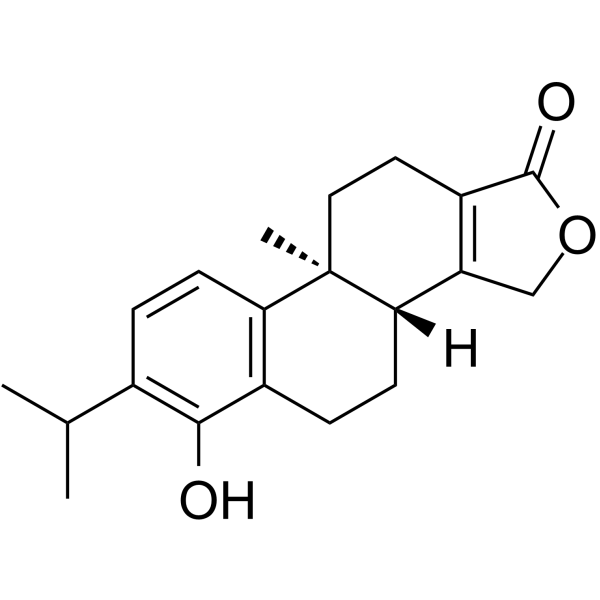上海金畔生物科技有限公司提供天然产物萜类及其苷类Terpenoids and Glycosides。
Triptophenolide (Synonyms: 雷酚内酯; Hypolide; (+)-Triptophenolide) 纯度: 99.63%
雷酚内酯 (Triptophenolide) 是从雷公藤的乙酸乙酯萃取部位分离到的一种无色晶体。

Triptophenolide Chemical Structure
CAS No. : 74285-86-2
| 规格 | 价格 | 是否有货 | 数量 |
|---|---|---|---|
| 10 mM * 1 mL in DMSO | ¥715 | In-stock | |
| 5 mg | ¥650 | In-stock | |
| 10 mg | ¥900 | In-stock | |
| 50 mg | 询价 | ||
| 100 mg | 询价 |
* Please select Quantity before adding items.
Triptophenolide 相关产品
•相关化合物库:
- Natural Product Library Plus
- Bioactive Compound Library Plus
- Natural Product Library
- Terpenoids Library
- Phenols Library
- Traditional Chinese Medicine Monomer Library
- Transcription Factor Targeted Library
| 生物活性 |
Triptophenolide is a colorless crystalline plate isolated from ethyl acetate extracts of Tripterygium wilfordii. IC50 value: Target: In vitro: Triptophenolide can remarkably inhibit the delayed type hypersensitivity (DTH) reaction induced by DNCB and BSA; and diminished the peripheral blood ANAE+lymphocytes in rats and micc. Moreover, triptophenolide can dramatically increase the amount of total serum complement and significautly decrcase the serum antibody products (1gG ) of rats and mice. The phagocytosis of perioneal exudate macrophages in mice present double effects in vitro [1]. In vivo: |
||||||||||||||||
|---|---|---|---|---|---|---|---|---|---|---|---|---|---|---|---|---|---|
| 分子量 |
312.40 |
||||||||||||||||
| Formula |
C20H24O3 |
||||||||||||||||
| CAS 号 |
74285-86-2 |
||||||||||||||||
| 中文名称 |
雷酚内酯 |
||||||||||||||||
| 运输条件 |
Room temperature in continental US; may vary elsewhere. |
||||||||||||||||
| 储存方式 |
|
||||||||||||||||
| 溶解性数据 |
In Vitro:
DMSO : 100 mg/mL (320.10 mM; Need ultrasonic) 配制储备液
*
请根据产品在不同溶剂中的溶解度选择合适的溶剂配制储备液;一旦配成溶液,请分装保存,避免反复冻融造成的产品失效。 In Vivo:
请根据您的实验动物和给药方式选择适当的溶解方案。以下溶解方案都请先按照 In Vitro 方式配制澄清的储备液,再依次添加助溶剂: ——为保证实验结果的可靠性,澄清的储备液可以根据储存条件,适当保存;体内实验的工作液,建议您现用现配,当天使用; 以下溶剂前显示的百
*以上所有助溶剂都可在 Shanghai Jinpan Biotech Co Ltd 网站选购。
|
||||||||||||||||
| 参考文献 |
|









